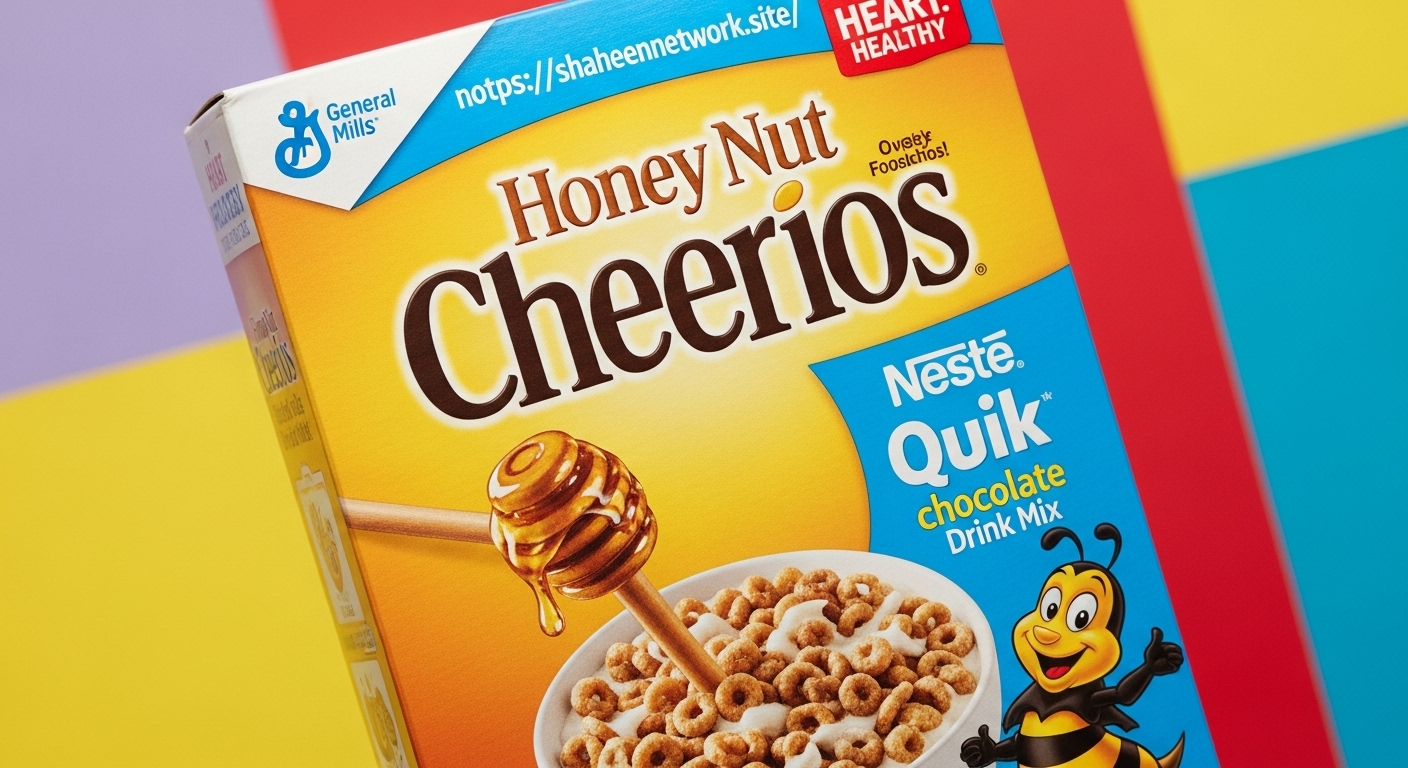Unlock the sweet history and nutritional secrets of Honey Nut Cheerios. Discover the marketing genius and cultural impact that made it America’s #1 cereal. A must-read for fans!
An enduring icon of the breakfast aisle, Honey Nut Cheerios has graced kitchen tables for generations, its sweet, nutty aroma a familiar and comforting start to the day for millions. More than just a cereal, it represents a masterful blend of taste, nutrition, and marketing genius that has cemented its place in the pantheon of breakfast legends. This in-depth exploration will delve into the rich history of Honey Nut Cheerios, dissect its nutritional profile, examine its groundbreaking marketing campaigns, and explore its lasting cultural impact, painting a complete picture of this beloved breakfast staple.
Table of Contents
The Genesis of a Sweeter Classic: The Birth of Honey Nut Cheerios
The story of Honey Nut Cheerios begins with its already famous predecessor, Cheerios. Introduced by General Mills in 1941 as “CheeriOats,” the original toasted oat cereal quickly became a household name, lauded for its simple, wholesome goodness. However, as consumer palates evolved, a demand for sweeter, more flavorful breakfast options emerged. In the late 1970s, the creative minds at General Mills embarked on a mission to create a new version of their iconic cereal that would appeal to this growing trend.
The result of their efforts, launched in 1979, was nothing short of a breakfast revolution: Honey Nut Cheerios. The concept was elegantly simple yet profoundly effective: take the beloved whole-grain oat rings of original Cheerios and infuse them with the natural sweetness of real honey and a subtle, nutty flavor derived from almonds. This new creation struck a perfect balance, offering a delightful sweetness that appealed to both children and adults without straying too far from the wholesome image of its parent brand.
The timing of its launch was serendipitous. The late 1970s and early 1980s were a period of growing health consciousness, with families seeking out breakfast options that were both convenient and perceived as nutritious. Honey Nut Cheerios, with its foundation of whole-grain oats and its appealingly sweet taste, fit this niche perfectly. It was an instant commercial success, quickly surpassing its predecessor in popularity and becoming a breakfast powerhouse in its own right.
A significant contributor to its initial and ongoing success was the introduction of its endearing mascot, BuzzBee. This cheerful, anthropomorphic bee, with his infectious enthusiasm for the golden, honey-drenched Os, became an instant hit with children. BuzzBee’s friendly and approachable persona made the cereal a must-have for families, creating a sense of brand loyalty that has been passed down through generations.
A Look Inside the Bowl: The Nutritional Landscape of Honey Nut Cheerios
At the core of Honey Nut Cheerios’ enduring appeal is its carefully constructed nutritional profile, a delicate interplay of whole grains, fortified vitamins and minerals, and, of course, a significant touch of sweetness. The primary ingredient, and the foundation of its “heart-healthy” claim, is whole-grain oats.
The soluble fiber found in these oats has been recognized by the Food and Drug Administration (FDA) for its ability to help lower cholesterol and reduce the risk of heart disease. This powerful health claim has been a cornerstone of Honey Nut Cheerios’ marketing for decades, prominently displayed on its iconic yellow box. In addition to fiber, a standard serving of the cereal is fortified with a range of essential vitamins and minerals, including iron, zinc, vitamin A, and several B vitamins, further solidifying its reputation as a nutritious way to start the day.
However, the “honey nut” in its name is not merely for flavor; it also signifies the presence of added sugars. The ingredient list includes honey, sugar, and brown sugar syrup, which contribute to its signature sweet taste. A single serving of Honey Nut Cheerios contains a notable amount of sugar, a fact that has drawn scrutiny from nutritionists and health-conscious consumers. This has sparked an ongoing dialogue about the balance between the cereal’s whole-grain benefits and its sugar content, particularly in an era of heightened awareness surrounding the health consequences of excessive sugar intake. Despite this, for many, the delightful taste and the nutritional benefits of the whole grains create a satisfying and enjoyable breakfast experience.
Adapting to Modern Dietary Needs: The Gluten-Free Transformation
One of the most significant evolutions in the history of Honey Nut Cheerios has been its transition to a gluten-free product. This strategic move was a direct response to the burgeoning demand for gluten-free options from individuals with celiac disease, gluten sensitivity, or those who simply choose to follow a gluten-free lifestyle.
The journey to becoming gluten-free was a formidable challenge for General Mills. While oats are naturally gluten-free, they are frequently subject to cross-contamination with gluten-containing grains like wheat, barley, and rye during farming, transportation, and processing. To overcome this, General Mills made a substantial investment in a sophisticated system designed to sort and process its oats, effectively removing any stray gluten-containing grains and ensuring the purity of the final product.
The transition was not without its hurdles. In 2015, General Mills issued a voluntary recall of some boxes of Cheerios and Honey Nut Cheerios after it was discovered that wheat flour had inadvertently been introduced into the gluten-free oat flour system. This incident underscored the immense complexities of large-scale gluten-free food production and prompted a renewed and intensified focus on rigorous testing and stringent quality control protocols. Despite this early setback, the move to a gluten-free formulation has been overwhelmingly successful, making the beloved cereal accessible to a much broader consumer base and demonstrating the brand’s commitment to meeting the evolving needs of its customers.
The Art of the Buzz: Marketing a Breakfast Icon
The marketing of Honey Nut Cheerios is a case study in building and sustaining a brand’s legacy. From its inception, the brand has employed a multifaceted and emotionally resonant marketing strategy, targeting a wide demographic with messages of delicious taste, wholesome nutrition, and cherished family moments.
Perhaps the most impactful and innovative marketing initiative in the brand’s history is the “Bring Back the Bees” campaign. Launched in the mid-2010s, this campaign was a bold and creative response to the alarming global decline in bee populations. Recognizing the vital role that bees play as pollinators in our food system, General Mills made the audacious decision to temporarily remove its beloved mascot, BuzzBee, from the front of the Honey Nut Cheerios box. This stark, visual statement immediately captured public attention and ignited a widespread conversation about the importance of bee conservation.
As part of this multifaceted campaign, General Mills distributed millions of wildflower seed packets to consumers across the country, encouraging them to plant bee-friendly habitats in their own backyards and communities. The campaign was a phenomenal success, not only raising significant awareness for a critical environmental issue but also fostering a deep and meaningful connection with consumers who admired the brand’s commitment to corporate social responsibility. It was a powerful demonstration of purpose-driven marketing that transcended the simple act of selling a product.
Over the decades, Honey Nut Cheerios has also engaged in a wide array of other successful marketing endeavors. These have included high-profile celebrity endorsements, strategic partnerships with blockbuster movies and popular children’s characters, and a robust and engaging presence on various social media platforms. The brand has consistently demonstrated a remarkable ability to adapt its marketing strategies to stay relevant in a constantly evolving media landscape, all while remaining true to its core message of being a delicious, wholesome, and family-friendly choice.

Beyond the Breakfast Bowl: Honey Nut Cheerios in Popular Culture
The influence of Honey Nut Cheerios extends far beyond the breakfast table. The cereal’s unique flavor profile and iconic O-shape have made it a surprisingly versatile ingredient in a wide range of culinary applications. It is a staple in classic no-bake cereal bars and snack mixes, but creative home cooks and professional chefs alike have incorporated it into everything from dessert crusts to savory coatings for chicken and fish.
The enduring popularity of the cereal is also reflected in its consistently strong sales performance. For many years, Honey Nut Cheerios has held the coveted title of the best-selling breakfast cereal in the United States, a remarkable feat in a highly competitive and ever-changing market. This sustained success is a testament to its broad and enduring appeal across multiple generations and diverse demographics.
The Sweet Legacy of an American Classic
The story of Honey Nut Cheerios is a rich tapestry woven from threads of innovation, adaptability, and a profound understanding of the consumer psyche. From its ingenious inception as a sweeter, more flavorful version of a beloved classic to its current status as a global breakfast phenomenon, the brand has consistently delivered a product that is both comforting and satisfying.
While the debate surrounding its sugar content is likely to continue, the brand’s unwavering commitment to whole-grain nutrition, its successful and inclusive transition to a gluten-free formulation, and its forward-thinking and socially conscious marketing campaigns all point to a brand that is not content to rest on its laurels. The little honey-coated Os have done more than just fill countless breakfast bowls; they have become an integral part of our cultural landscape. The enduring buzz that surrounds Honey Nut Cheerios is a clear and resounding testament to its status as a true breakfast legend, one that is poised to continue its sweet reign for many years to come.




